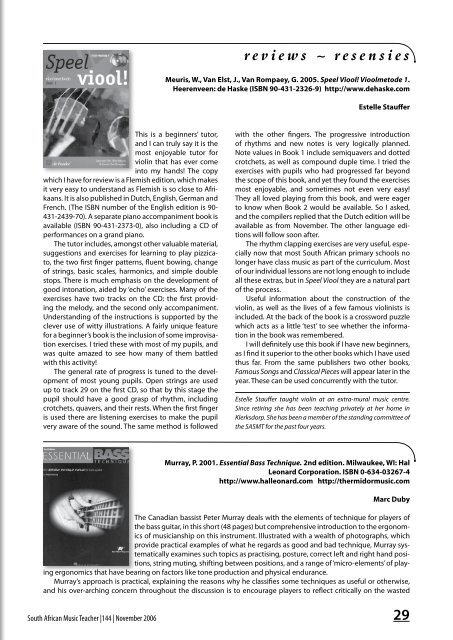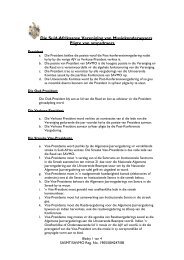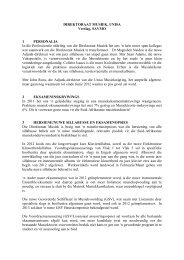2006 Edition 2 (Issue 144) - Sasmt-savmo.org.za
2006 Edition 2 (Issue 144) - Sasmt-savmo.org.za
2006 Edition 2 (Issue 144) - Sasmt-savmo.org.za
Create successful ePaper yourself
Turn your PDF publications into a flip-book with our unique Google optimized e-Paper software.
This is a beginners’ tutor,<br />
and I can truly say it is the<br />
most enjoyable tutor for<br />
violin that has ever come<br />
into my hands! The copy<br />
which I have for review is a Flemish edition, which makes<br />
it very easy to understand as Flemish is so close to Afrikaans.<br />
It is also published in Dutch, English, German and<br />
French. (The ISBN number of the English edition is 90-<br />
431-2439-70). A separate piano accompaniment book is<br />
available (ISBN 90-431-2373-0), also including a CD of<br />
performances on a grand piano.<br />
The tutor includes, amongst other valuable material,<br />
suggestions and exercises for learning to play pizzicato,<br />
the two first finger patterns, fluent bowing, change<br />
of strings, basic scales, harmonics, and simple double<br />
stops. There is much emphasis on the development of<br />
good intonation, aided by ‘echo’ exercises. Many of the<br />
exercises have two tracks on the CD: the first providing<br />
the melody, and the second only accompaniment.<br />
Understanding of the instructions is supported by the<br />
clever use of witty illustrations. A fairly unique feature<br />
for a beginner’s book is the inclusion of some improvisation<br />
exercises. I tried these with most of my pupils, and<br />
was quite amazed to see how many of them battled<br />
with this activity!<br />
The general rate of progress is tuned to the development<br />
of most young pupils. Open strings are used<br />
up to track 29 on the first CD, so that by this stage the<br />
pupil should have a good grasp of rhythm, including<br />
crotchets, quavers, and their rests. When the first finger<br />
is used there are listening exercises to make the pupil<br />
very aware of the sound. The same method is followed<br />
South African Music Teacher |<strong>144</strong> | November <strong>2006</strong><br />
r e v i e w s ~ r e s e n s i e s<br />
Meuris, W., Van Elst, J., Van Rompaey, G. 2005. Speel Viool! Vioolmetode 1.<br />
Heerenveen: de Haske (ISBN 90-431-2326-9) http://www.dehaske.com<br />
Estelle Stauffer<br />
with the other fingers. The progressive introduction<br />
of rhythms and new notes is very logically planned.<br />
Note values in Book 1 include semiquavers and dotted<br />
crotchets, as well as compound duple time. I tried the<br />
exercises with pupils who had progressed far beyond<br />
the scope of this book, and yet they found the exercises<br />
most enjoyable, and sometimes not even very easy!<br />
They all loved playing from this book, and were eager<br />
to know when Book 2 would be available. So I asked,<br />
and the compilers replied that the Dutch edition will be<br />
available as from November. The other language editions<br />
will follow soon after.<br />
The rhythm clapping exercises are very useful, especially<br />
now that most South African primary schools no<br />
longer have class music as part of the curriculum. Most<br />
of our individual lessons are not long enough to include<br />
all these extras, but in Speel Viool they are a natural part<br />
of the process.<br />
Useful information about the construction of the<br />
violin, as well as the lives of a few famous violinists is<br />
included. At the back of the book is a crossword puzzle<br />
which acts as a little ‘test’ to see whether the information<br />
in the book was remembered.<br />
I will definitely use this book if I have new beginners,<br />
as I find it superior to the other books which I have used<br />
thus far. From the same publishers two other books,<br />
Famous Songs and Classical Pieces will appear later in the<br />
year. These can be used concurrently with the tutor.<br />
Estelle Stauffer taught violin at an extra-mural music centre.<br />
Since retiring she has been teaching privately at her home in<br />
Klerksdorp. She has been a member of the standing committee of<br />
the SASMT for the past four years.<br />
Murray, P. 2001. Essential Bass Technique. 2nd edition. Milwaukee, WI: Hal<br />
Leonard Corporation. ISBN 0-634-03267-4<br />
http://www.halleonard.com http://thermidormusic.com<br />
Marc Duby<br />
The Canadian bassist Peter Murray deals with the elements of technique for players of<br />
the bass guitar, in this short (48 pages) but comprehensive introduction to the ergonomics<br />
of musicianship on this instrument. Illustrated with a wealth of photographs, which<br />
provide practical examples of what he regards as good and bad technique, Murray systematically<br />
examines such topics as practising, posture, correct left and right hand positions,<br />
string muting, shifting between positions, and a range of ‘micro-elements’ of playing<br />
ergonomics that have bearing on factors like tone production and physical endurance.<br />
Murray’s approach is practical, explaining the reasons why he classifies some techniques as useful or otherwise,<br />
and his over-arching concern throughout the discussion is to encourage players to reflect critically on the wasted




